
Apulia, also known by its Italian name Puglia, is a region of Italy, located in the southern peninsular section of the country, bordering the Adriatic Sea to the east, the Ionian Sea to the southeast and the Strait of Otranto and Gulf of Taranto to the south. The region comprises 19,345 square kilometers (7,469 sq mi), and its population is about four million people.

Otranto is a coastal town, port and comune in the province of Lecce, in a fertile region once famous for its breed of horses.

Brindisi is a city in the region of Apulia in southern Italy, the capital of the province of Brindisi, on the coast of the Adriatic Sea. Historically, the city has played an important role in trade and culture, due to its strategic position on the Italian Peninsula and its natural port on the Adriatic Sea. The city remains a major port for trade with Greece and the Middle East. Its industries include agriculture, chemical works, and the generation of electricity.

Salento is a cultural, historical and geographic region at the southern end of the administrative region of Apulia in Southern Italy. It is a sub-peninsula of the Italian Peninsula, sometimes described as the "heel" of the Italian "boot". It encompasses the entire administrative area of the province of Lecce, a large part of the province of Brindisi and part of that of Taranto.

The Province of Lecce is a province in the Apulia region of Italy whose capital is the city of Lecce. The province is called the "Heel of Italy". Located on the Salento peninsula, it is the second most-populous province in Apulia and the 21st most-populous province in Italy.

Negroamaro is a red wine grape variety native to southern Italy. It is grown almost exclusively in Apulia and particularly in Salento, the peninsula which can be visualised as the "heel" of Italy. The grape can produce wines very deep in color. Wines made from Negroamaro tend to be very rustic in character, combining perfume with an earthy bitterness. The grape produces some of the best red wines of Apulia, particularly when blended with the highly scented Malvasia Nera, as in the case of Salice Salentino.
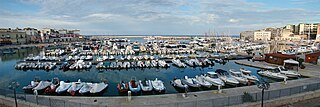
Bisceglie is a city and municipality of 55,251 inhabitants in the province of Barletta-Andria-Trani, in the Apulia region, in southern Italy. The municipality has the fourth highest population in the province and fourteenth highest in the region.

Gallipoli is a southern Italian town and comune in the province of Lecce, in Apulia. In 2014, it had a population of 31,862 and is one of the towns where the Greek dialect Griko is spoken.

San Vito dei Normanni is an Italian town of 19,947 inhabitants of the province of Brindisi in Apulia. The inhabitants are called Sanvitesi and the town is sometimes referred to as San Vito.
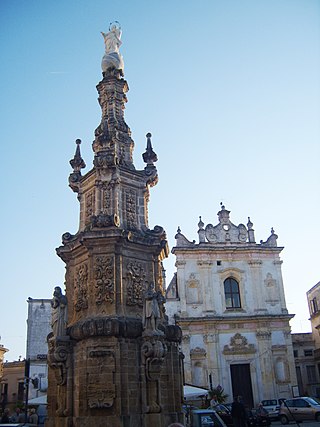
Nardò is a town and comune in the southern Italian region of Apulia, in the Province of Lecce.
Carmiano is a town and comune in the province of Lecce in the Apulia region of south-east Italy. Carmiano is in the heart of the province of Lecce and Salento. It is located 20 kilometres (12 mi) east of the Ionian Sea and 16 kilometres (10 mi) west of the Adriatic Sea.
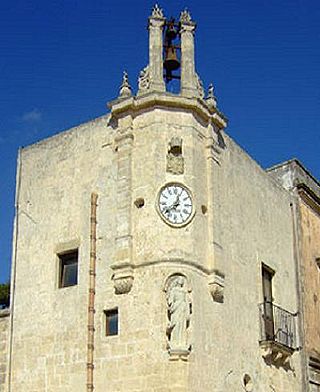
Spongano is a town and comune in the province of Lecce, in the Apulia region of south-east Italy. It is located among the olive groves of Puglia's Salento, and retains its rural character while being just a few minutes to the Adriatic Sea. The rocky shore provides hidden coves interrupted by sandy beaches and reefs. The town bears witness to humanity's prehistoric presence with the dolmen called Piedi Grandi along with other megaliths and mehir.
Sant'Elia a Pianisi is a comune (municipality) in the Province of Campobasso in the Italian region Molise, located about 20 kilometres (12 mi) northeast of Campobasso. As of 31 December 2004, it had a population of 2,178 and an area of 67.8 square kilometres (26.2 sq mi).

The Griko people, also known as Grecanici in Calabria, are an ethnic Greek community of Southern Italy. They are found principally in regions of Calabria and Apulia. The Griko are believed to be remnants of the once large Ancient and Medieval Greek communities of southern Italy, although there is dispute among scholars as to whether the Griko community is directly descended from Ancient Greeks or from more recent medieval migrations during the Byzantine domination.
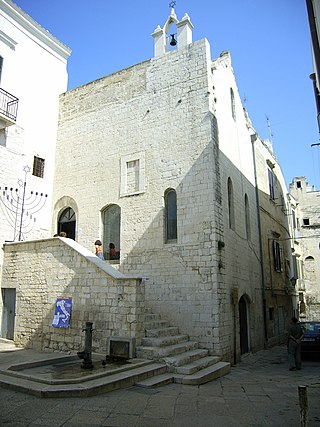
The history of the Jews in Apulia can be traced back over two thousand years. Apulia in Hebrew:פוליה) is a region in the "heel of the boot" of the peninsula of Italy bordering the Adriatic Sea. The Jews have had a presence in Apulia for at least 2000 years. The Jews of Apulia had a rich Rabbinic tradition and also had a sizeable Jewish population in the central Mediterranean prior to their expulsion.
Trinitapoli-San Ferdinando di Puglia is a railway station in the Italian town of Trinitapoli and also for San Ferdinando di Puglia, in the Province of Barletta-Andria-Trani, Apulia. The station lies on the Adriatic Railway (Ancona–Lecce). The train services are operated by Trenitalia.
Banca Popolare di Puglia e Basilicata S.C.p.A. is an Italian cooperative bank based in Altamura, in the Province of Bari, Apulia.
Banca Popolare Pugliese S.C.p.A. (BPP) is an Italian cooperative bank based in Parabita and Matino, in the Province of Lecce, Apulia region.
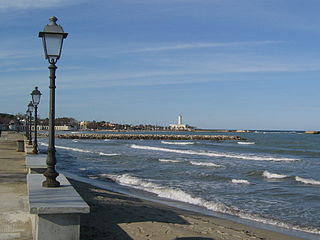
Punta San Cataldo di Lecce Lighthouse is an active lighthouse located on the eastern point of San Cataldo di Lecce in the Salentine Peninsula 12 kilometres (7.5 mi) from Lecce on the Adriatic Sea.

The extra-virgin olive oil Terra d'Otranto is produced with the olive cultivars Cellina di Nardò and Ogliarola for, at least, 60%. They are mixed with other minor varieties of the local olive groves. Its name is linked with the historical region of Terra d'Otranto which included almost all the municipalities of the current provinces of Taranto, Brindisi and Lecce. It is recognised as PDO product.














